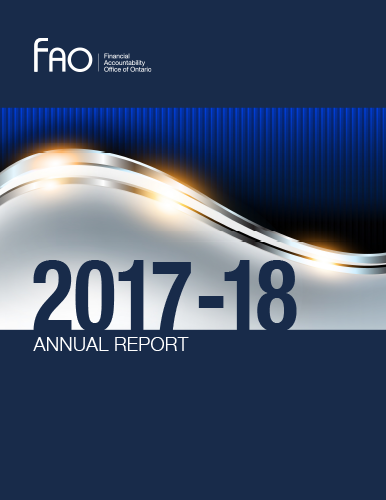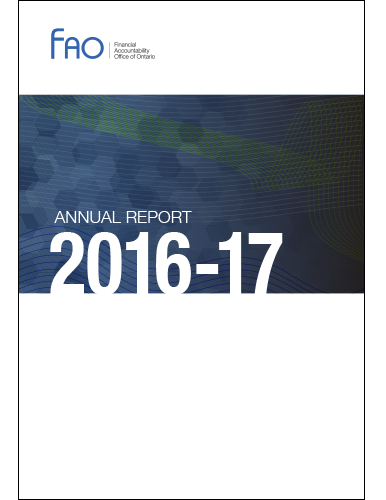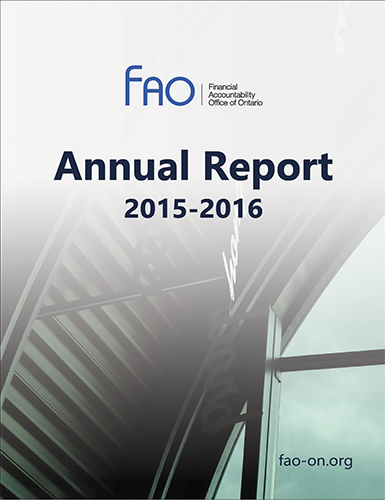July 2020
The Honourable Ted Arnott
Speaker of the Legislative Assembly of OntarioMain Legislative Building, Room 180
Queen’s Park
Toronto, Ontario
M7A 1A2Dear Mr. Speaker:
In accordance with section 14 of the Financial Accountability Officer Act, 2013, I am pleased to present the 2019 – 20 Annual Report of the Financial Accountability Officer for your submission to the Legislative Assembly at the earliest reasonable opportunity.
Sincerely,

Peter Weltman
Financial Accountability Officer
Officer’s Note

In my second year as Ontario’s Financial Accountability Officer, I remain invigorated by our mission to enhance legislative debate in Ontario by providing relevant, authoritative, and timely information on the financial impact of government policies.
At the core of this work is our commitment to realizing our vision as the trusted source for independent analysis of Ontario’s finances and trends in the provincial economy. That means extending our support for Members of Provincial Parliament (MPPs) beyond the Legislature to the environment in which they operate, including media, external organizations and constituents who are looking for a neutral, non-partisan voice around the economic and financial issues facing our province.
To determine what new products would be most valuable to MPPs, the FAO commissioned two MPP engagement surveys. The results helped propel the launch of the FAO’s new digital strategy, where videos and infographics would accompany our reports. With new and innovative products, MPPs could thereby use our platform as a source for fact-based content to enhance communications with their constituencies.
So far, our approach is working.
We exceeded expectations by producing a record 19 reports in 2019-20 and increased our engagement with MPPs in-person, on committees, and through our digital channels. Some of our notable achievements included the introduction of Estimates Reports, a first-of-its-kind Expenditure Monitor, and shareable videos that have received over 20,000 views.
It is important to note that none of this could be achieved without two critical ingredients: access to government information, which provides the base content for the FAO’s work; and an incredibly talented and dedicated FAO team, who are equally invigorated with producing useful, innovative and authoritative publications for MPPs and all Ontarians.
Looking ahead, we expect to see a significant increase in MPP and Committee requests in 2020-21 due to economic and fiscal impacts from COVID-19 and the election coming up in 2022. Thankfully, the FAO is ready to meet this challenge with a fully staffed office of 20 who are ready and eager to help support financial accountability in Ontario.
I believe the FAO had a tremendous 2019-20 and is likely to exceed expectations once again in 2020-21.
Sincerely,
Peter Weltman
Financial Accountability Officer
Mandate & Activities
Overview
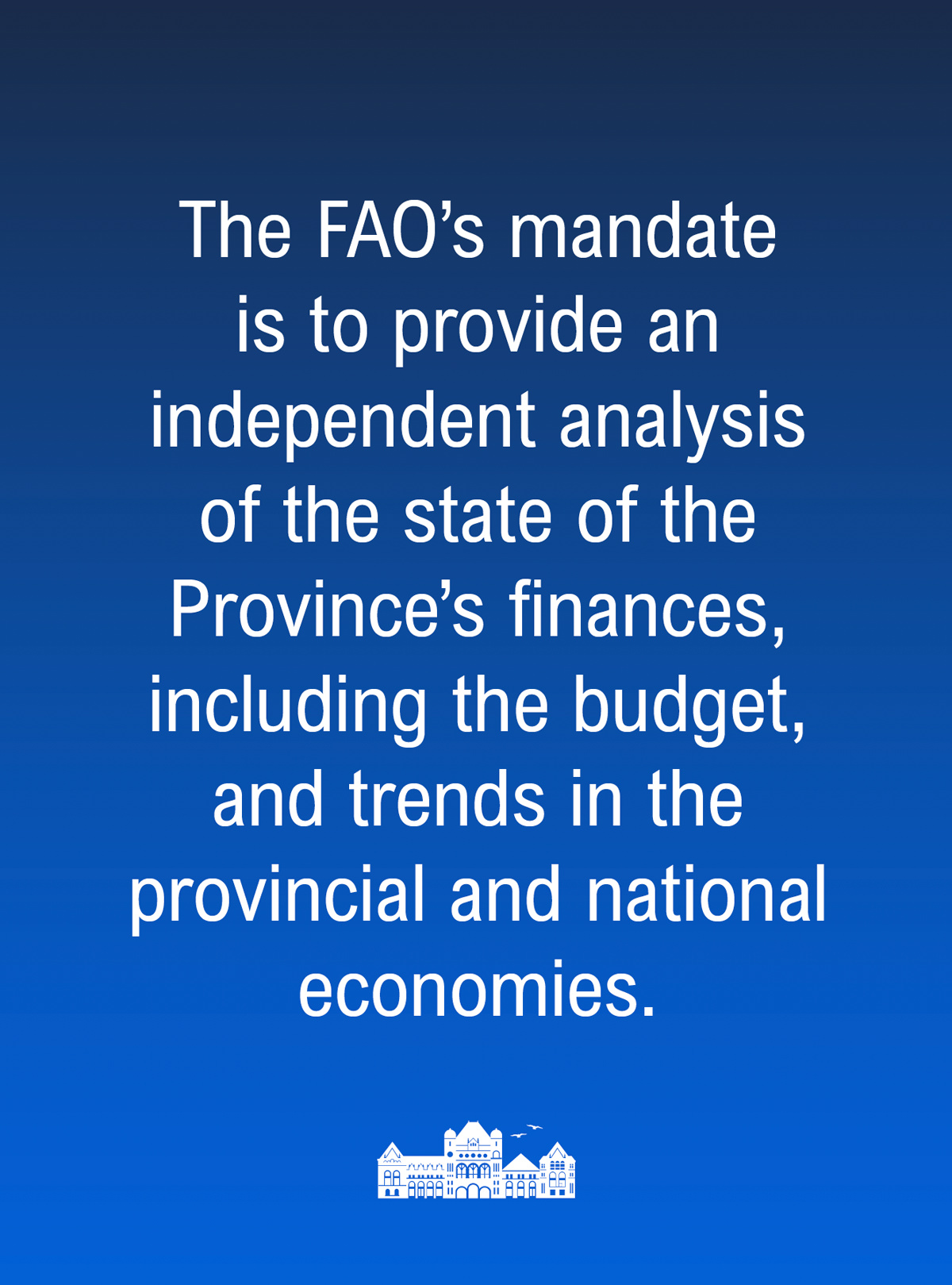
Established by the Financial Accountability Officer Act, 2013, the Financial Accountability Office (FAO) provides independent analysis on the state of the Province’s finances, trends in the provincial economy, and related matters important to the Legislative Assembly of Ontario.
The Financial Accountability Officer is an independent, non-partisan officer of the Legislative Assembly. The Officer’s primary role is to support Members of Provincial Parliament (MPPs) as they perform their constitutional function to review and approve the government’s spending and taxation plans. The FAO provides MPPs with timely, relevant, and authoritative economic and financial analysis.
The FAO provides its analysis to MPPs in the form of public reports, videos, and infographics, all of which are posted to the FAO’s website and social media channels to increase accessibility and awareness.
The FAO’s Work
The FAO’s mandate is to provide an independent analysis of the state of the Province’s finances, including the budget, and trends in the provincial and national economies. Work is undertaken in response to requests from MPPs or on the initiative of the Financial Accountability Officer. In 2019-20, the FAO produced 19 reports, under several broad themes:
- Ontario’s economic performance
- Ontario’s fiscal position
- Ministry or sectoral spending plans
- Financial analysis of specific government policies
Ontario’s Economic and Fiscal Performance
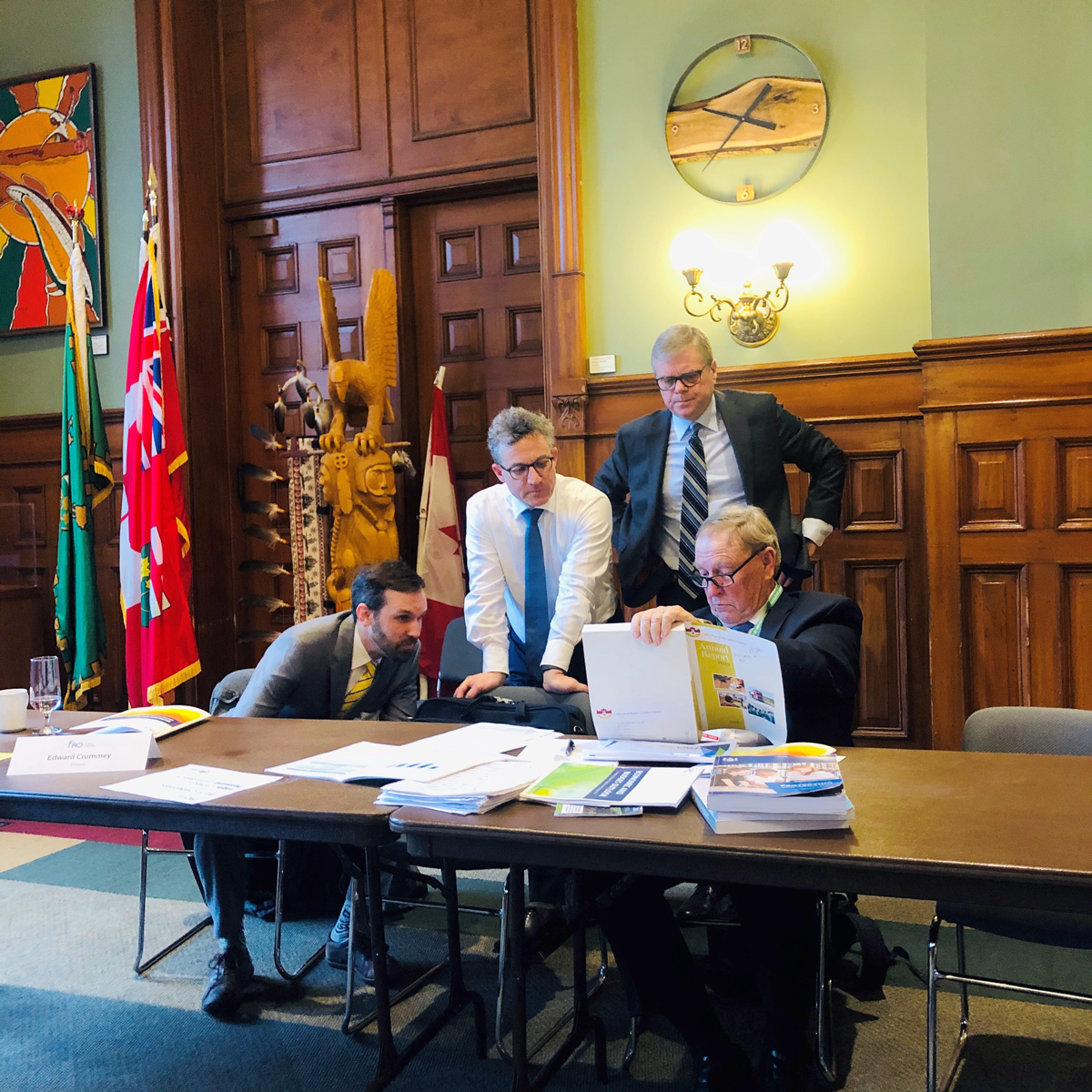
A key priority for the FAO and an important part of its mandate is to provide regular forecasts of Ontario’s economy and the outlook for the Province’s financial position. The FAO delivers on this priority by releasing bi-annual Economic and Budget Outlook (EBO) reports, which examine the province’s medium-term budget plans given the outlook for Ontario’s economy. The EBOs provide MPPs with a timely and independent outlook for the Province’s fiscal position, helping them better assess the government’s own fiscal statements.
Every two years, the FAO releases a Long-Term Budget Outlook (LTBO) report, which provides a forecast of Ontario’s economy and fiscal position through 2050, based on current fiscal policies. This year, the FAO released its second long-term report entitled: Long-Term Budget Outlook: Fiscal Implications of the Government’s Program Reforms: 2020-2050. The report highlighted the important demographic changes that will occur over the next 30 years and how the government’s plan to limit growth in program spending would be expected to impact Ontario’s long-term fiscal position.
In addition to medium and long-term forecasts, the FAO also produces regular reports that look at important economic and fiscal trends. These reports include an annual assessment of Ontario’s labour market including important trends and developments. This year’s labour market report looked at the uneven gains in labour markets across the province’s communities and the continuing rise in self-employment and part-time work.
The FAO also released its annual Update on Ontario’s Credit Rating report, which provides a summary of how Ontario’s debt is rated by the four major international credit rating agencies. This year’s report noted that despite a strong investment-grade credit rating, the agencies all cited concerns regarding Ontario’s credit outlook, including the Province’s elevated debt burden, the prolonged and on-going period of budget deficits, and an outlook for relatively moderate economic growth, compounded by heightened risks.
Last summer the FAO released a report which examined the impact of an economic downturn on the Province’s finances. The analysis included the development of a reasonable but hypothetical scenario in which the Ontario economy experienced a moderate recession. The purpose of the analysis was to assess the vulnerability of the government’s budget plan if a moderate economic downturn were to occur. Under the recession scenario, government revenues would decline while spending on some programs, such as employment training and social services, would be expected to increase. The report concluded that even a moderate recession would present significant challenges to the government’s commitments to balance the budget and avoid increases in the debt-to-GDP ratio.
In another report, Understanding Ontario’s 2018-19 Deficit, the FAO examined how policy decisions by both the previous and current governments contributed to the doubling in Ontario’s deficit from $3.7 billion in 2017-18 to $7.4 billion in 2018-19.
Government Spending Plans
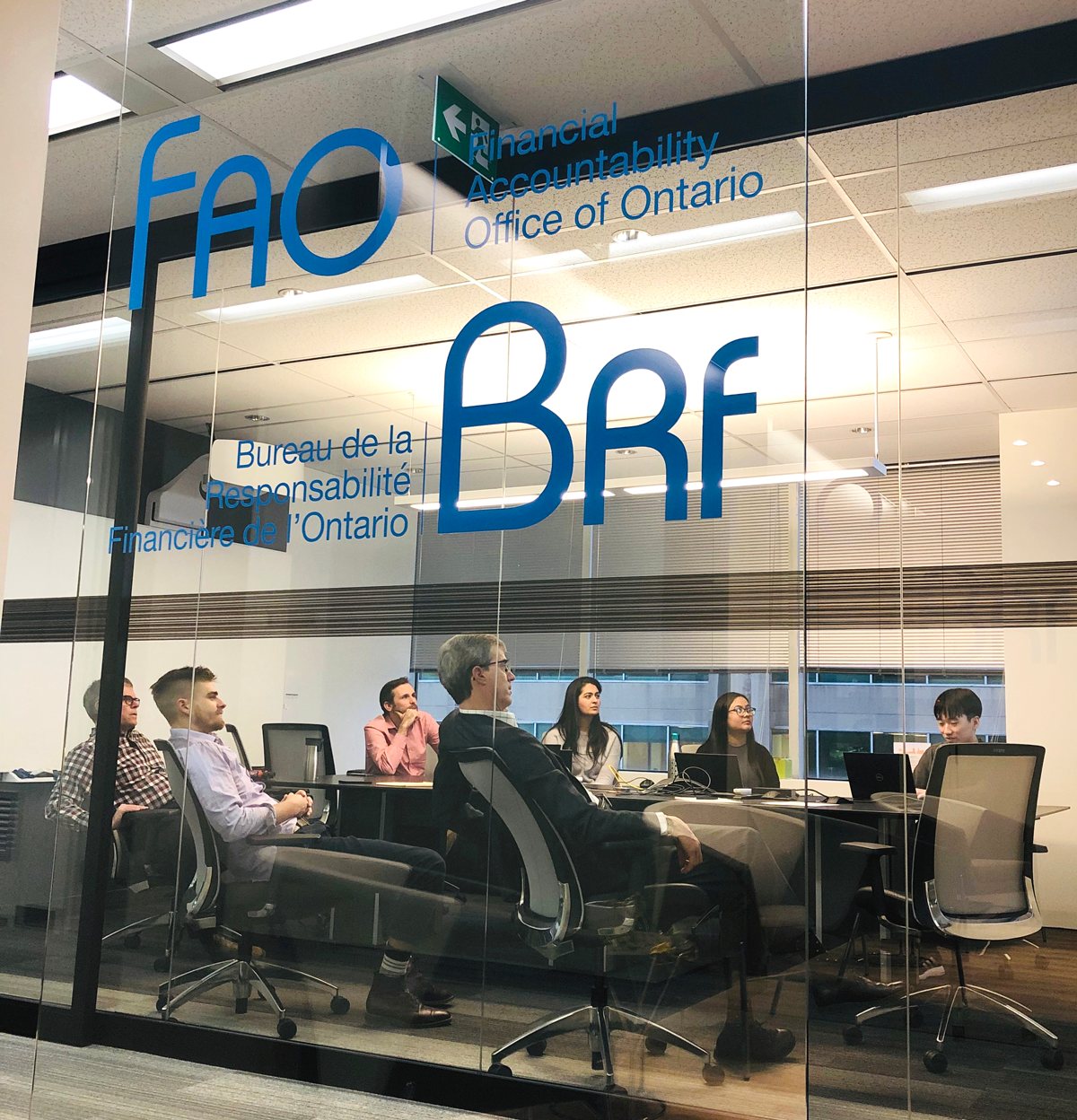
In 2019-20, the FAO reviewed the government’s Expenditure Estimates for three key ministries, Education, Transportation and Health and Long-Term Care. The estimates provide an outline for spending of public funds that must be approved by the Legislature. The purpose of the FAO’s Expenditure Estimates reports is to assist members of the Standing Committee on Estimates as they review government spending plans.
- The Expenditure Estimates 2019-20: Ministry of Transportation report provided a financial overview of the ministry and discussed the government’s five-year transit and highway capital plans. The report further reviewed proposed 2019-20 spending by program and identified trends in transportation spending and program changes.
- The Expenditure Estimates 2019-20: Ministry of Education report examined trends in education spending and analyzed measures announced by the Province to achieve the ministry’s spending plan, including increasing class sizes and wage restraint.
- The Expenditure Estimates 2019-20: Ministry of Health and Long-Term Care report provided a financial overview of the ministry and identified key issues for 2019-20, including new spending restraint measures and the Province’s commitment to end “hallway health care.”
Also in 2019-20, the FAO released a new type of report, the Expenditure Monitor, intended to assist MPPs in tracking provincial spending and changes to program budgets over the course of the year. Previously, after the release of a fiscal year’s spending plan in a provincial budget and the Expenditure Estimates, changes to the spending plan and actual spending results were not disclosed until over a year later, with the release of the Public Accounts. This limited MPPs ability to review and scrutinize the government’s spending plan.
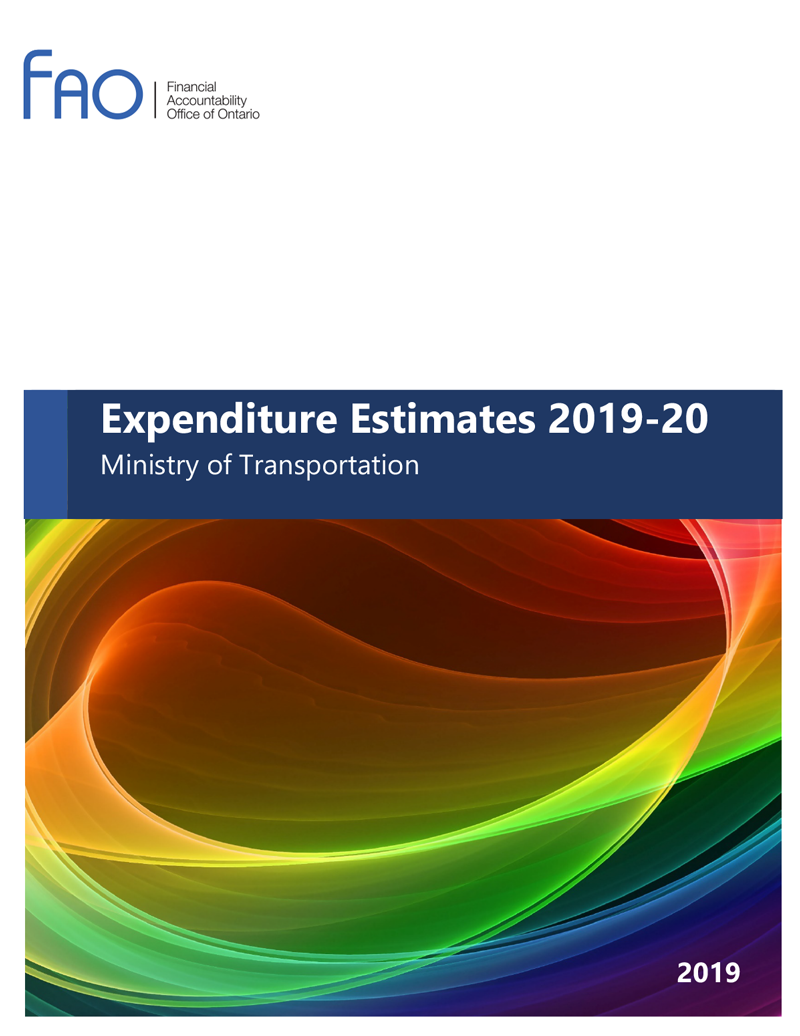
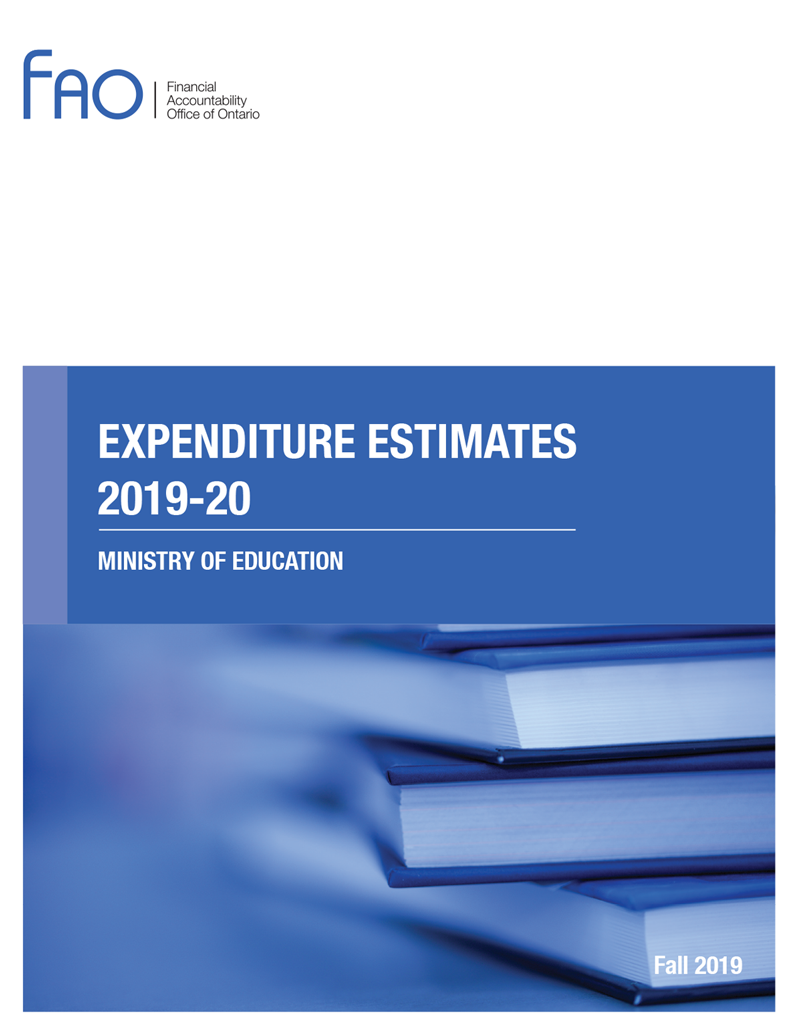
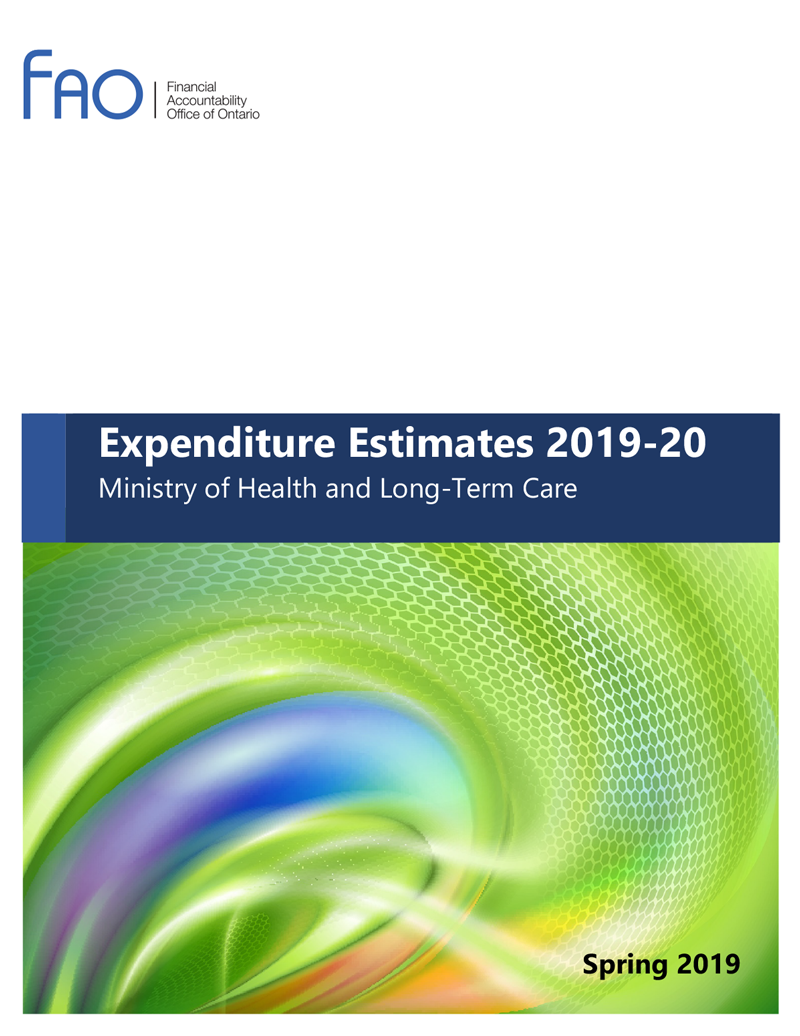
Cover pages of Expenditure Estimates 2019-20: Ministry of Transportation, Expenditure Estimates 2019-20: Ministry of Education and Expenditure Estimate 2019-20: Ministry of Health and Long-Term Care, respectively.
The Expenditure Monitor 2019-20: Q2 detailed spending by the Province during the first six months of the 2019-20 fiscal year (as of September 30, 2019), and identified changes made to program budgets. The report found the Province changed the budgets of 86 programs, with significant variance compared to program budgets reported in the Province’s 2019 Fall Economic Statement.
The Expenditure Monitor 2019-20: Q3 provided information on spending for the first nine months of the 2019-20 fiscal year (as of December 31, 2019), including changes to the 2019 budget spending plan, actual spending results compared to planned spending and an updated budget deficit projection. The assessment found that although the government’s 2019-20 spending plan had increased by $2.5 billion actual spending was $2.0 billion lower than planned, resulting in a lower forecasted deficit.
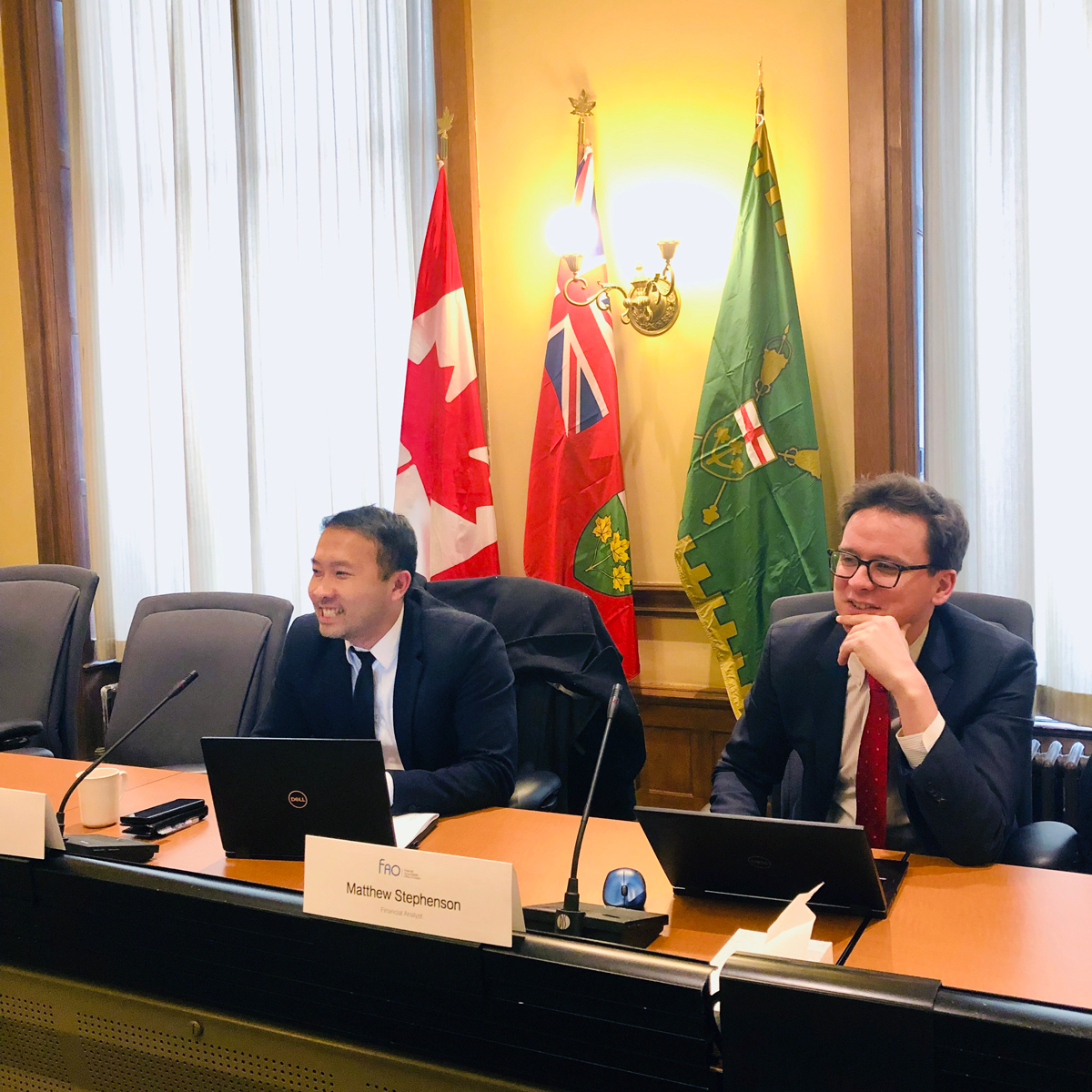
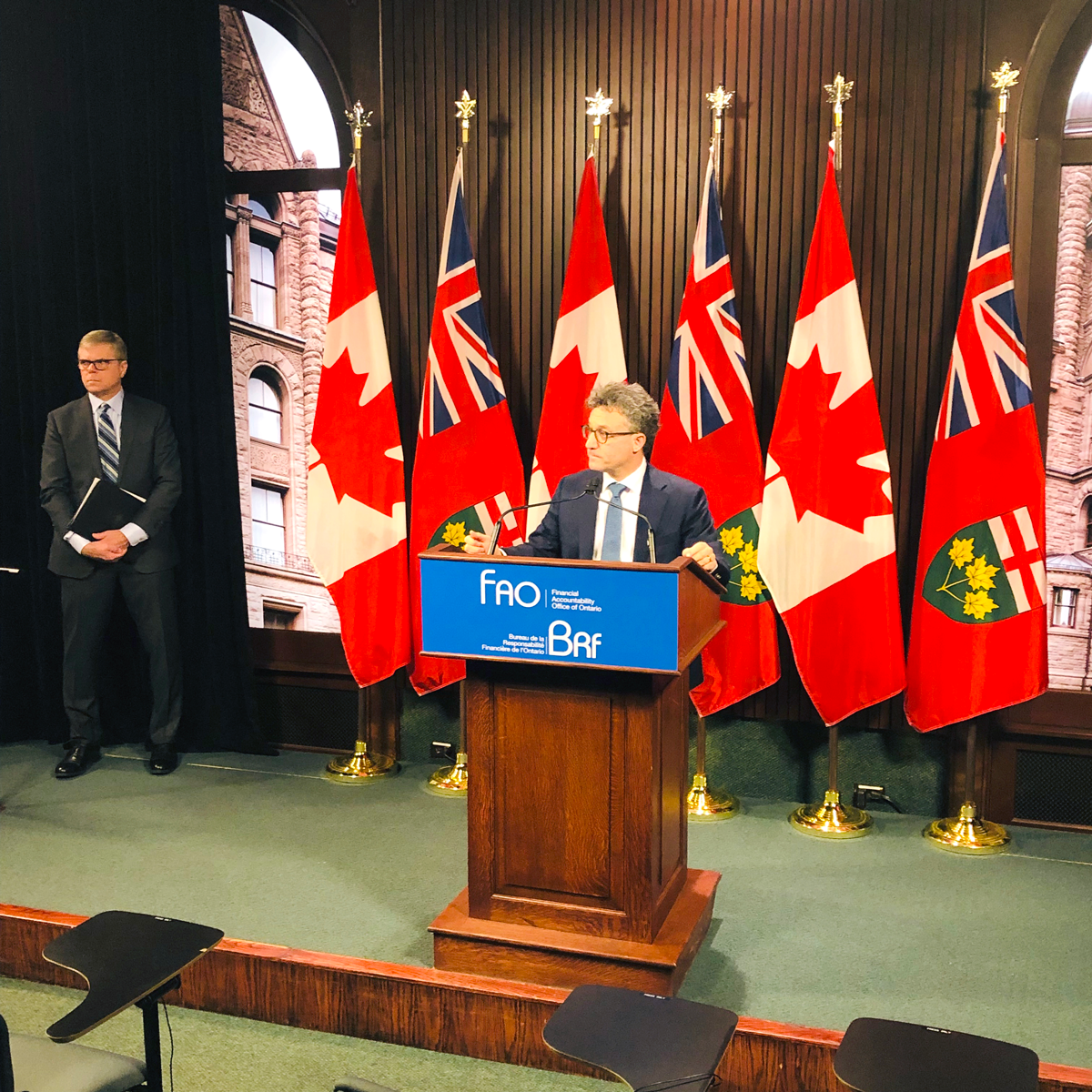
Financial Analysis of Specific Government Polices
At the request of MPPs or by its own accord, the FAO provides financial analysis of specific government policies. In 2019-20, work completed by the FAO included:
- An assessment of the long-term care homes program, including an estimate of the cost of the government’s commitment to create 15,000 new long-term care beds, projected changes to the long-term care wait list and wait times, and the potential impact to the Province’s goal to end “hallway health care”;
- A first of its kind report on the oversight, growth and distribution of tax expenditures in Ontario, citing the overall cost to government, either in the form of a reduction in tax revenue or an increase in program spending;
- An assessment of the financial and economic implications of the Province’s new Childcare Access and Relief from Expenses (CARE) tax credit;
- A comparison of the new Low-income Individuals and Families Tax (LIFT) credit to a minimum wage increase. The report found that the LIFT credit would provide fewer benefits to Ontarians than increasing the minimum wage from $14 per hour to $15 per hour;
- A 2019 update on home energy spending in Ontario, which assessed what Ontarians pay to heat and cool their homes and power their appliances. The report found that over the last ten years, Ontario households experienced the smallest increase in home energy costs in Canada, by a significant margin; and
- A review of Ontario service fees in 2019-20, including service fee rate changes in 2019-20, service fee revenue sources and growth rates, the most used services by number of transactions and the usage of ServiceOntario’s online service delivery.
Use of the FAO’s work
Overview
The FAO’s mission is to enhance legislative debate in Ontario by providing MPPs, committees, media and the public with relevant, authoritative and timely information on the financial impact of government policies. To determine the effectiveness of its reports, the FAO tracks key metrics including mentions in the Ontario Legislature, media coverage, and conversations on social media platforms.
In 2019-20, the FAO was mentioned 189 times in the Ontario Legislature, for an average of 2.4 times per sitting day. When looking at media coverage, the FAO was mentioned in 3,695 news articles and broadcasts. By far the most significant increase in engagement occurred on the FAO’s website, which received 179,760 unique views, more than double the previous year, and on Twitter, where the FAO received 902 mentions (a ten-fold increase from last year).


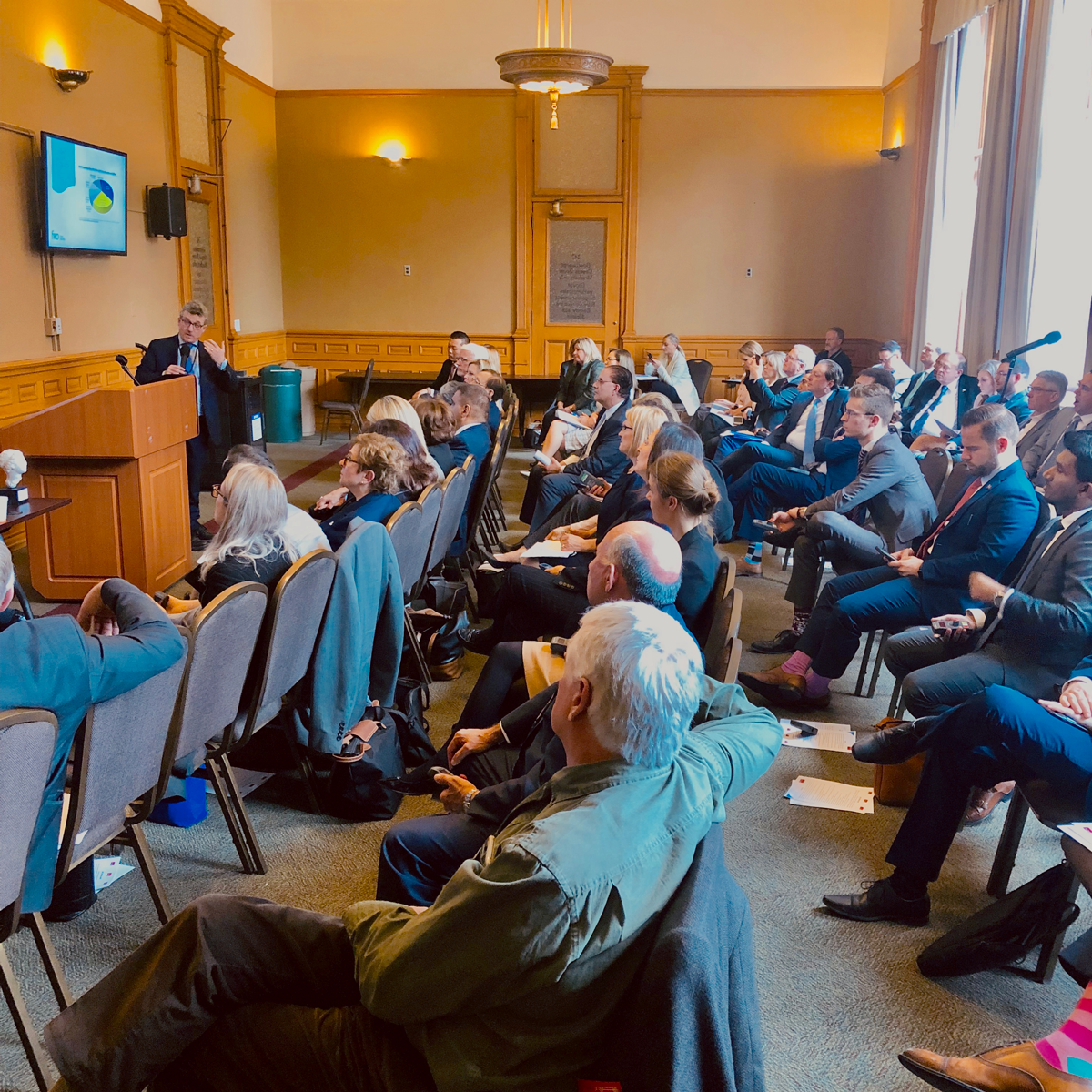
Requests from MPPs and Committees
The FAO may undertake research for both MPPs and committees when requests fall under the FAO’s statutory mandate and the FAO has available research capacity.
In 2019-20, the FAO received 10 research requests from MPPs, resulting in four reports. The remaining requests were either pushed to subsequent years or unfulfilled due to increasing demands for the FAO’s limited resources.
The FAO did not receive any research requests from Committees. While the FAO will not disclose the source of a request, an MPP or Committee is free to identify themselves as they wish.
MPP Engagement
The success of any organization is determined by how its key stakeholders perceive its value. That is why, in 2019-20, the FAO commissioned two MPP surveys to better understand its effectiveness and gain new insights into how its engagement strategy could be improved. To ensure confidentiality, the FAO commissioned Fleishman Hillard Highroad and Leger Research firms to assist in the collection of data.
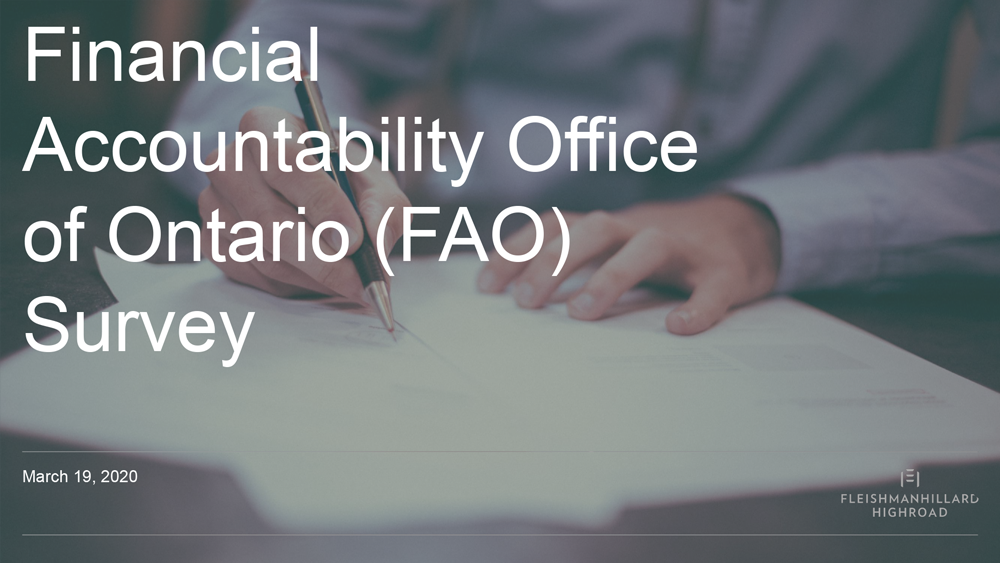
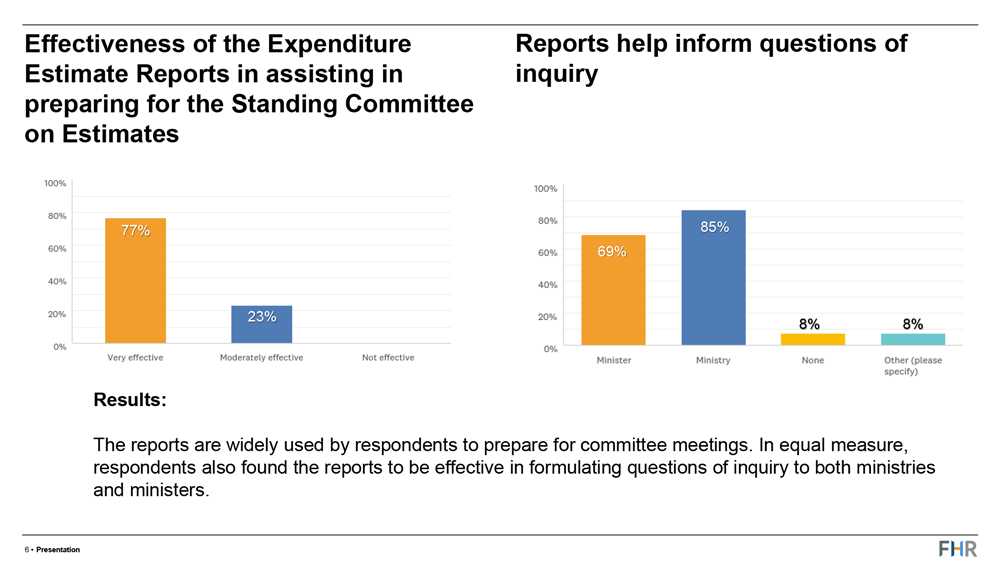
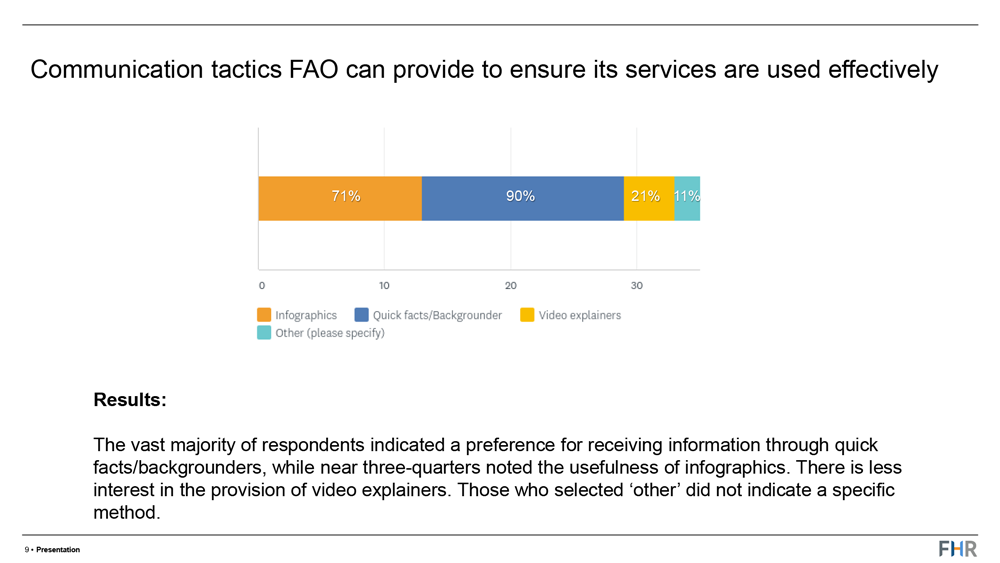
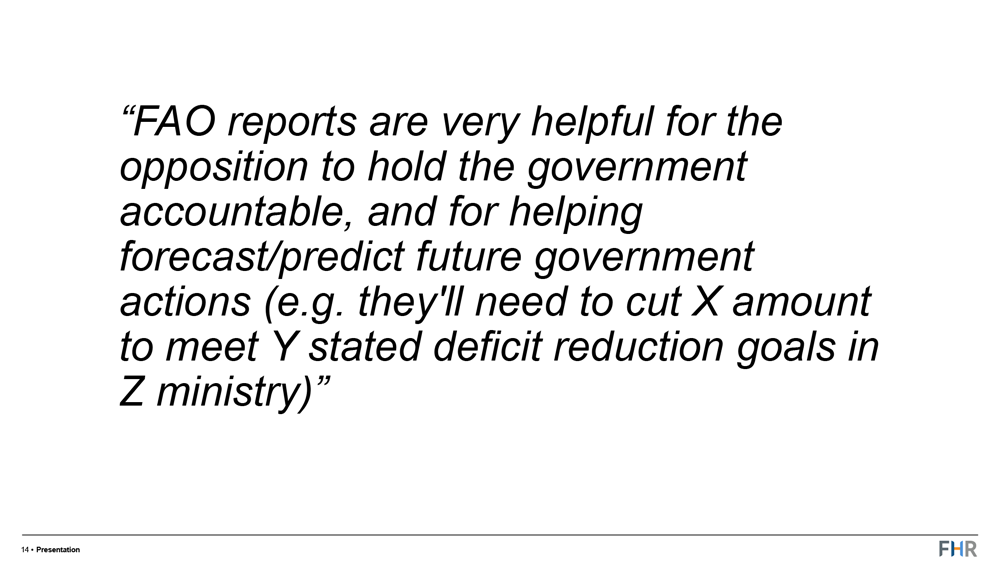
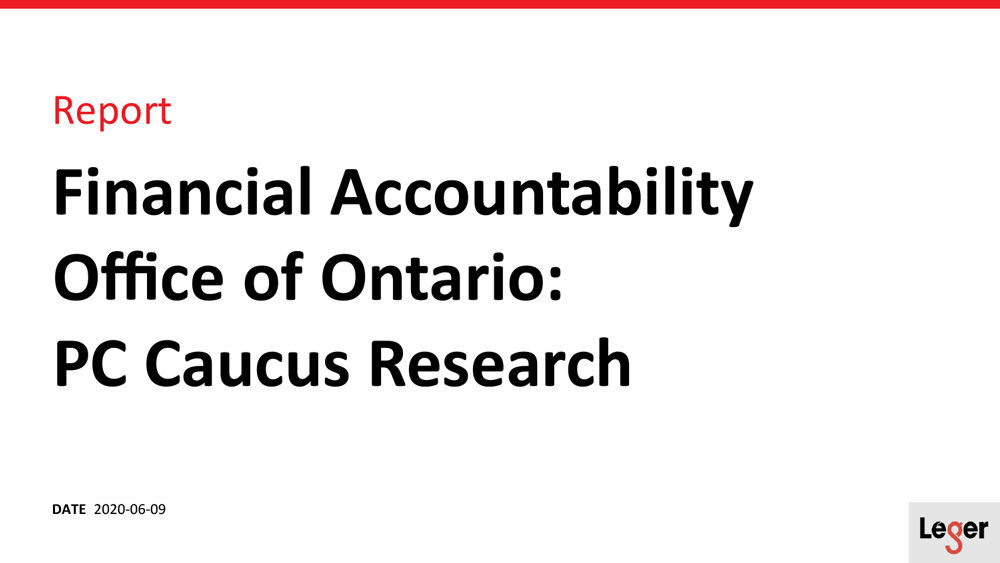
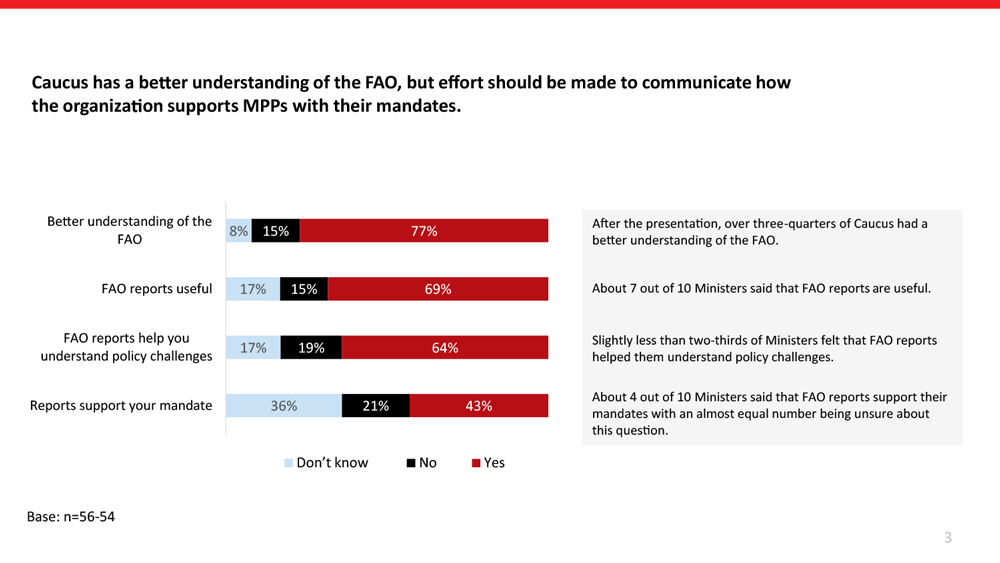
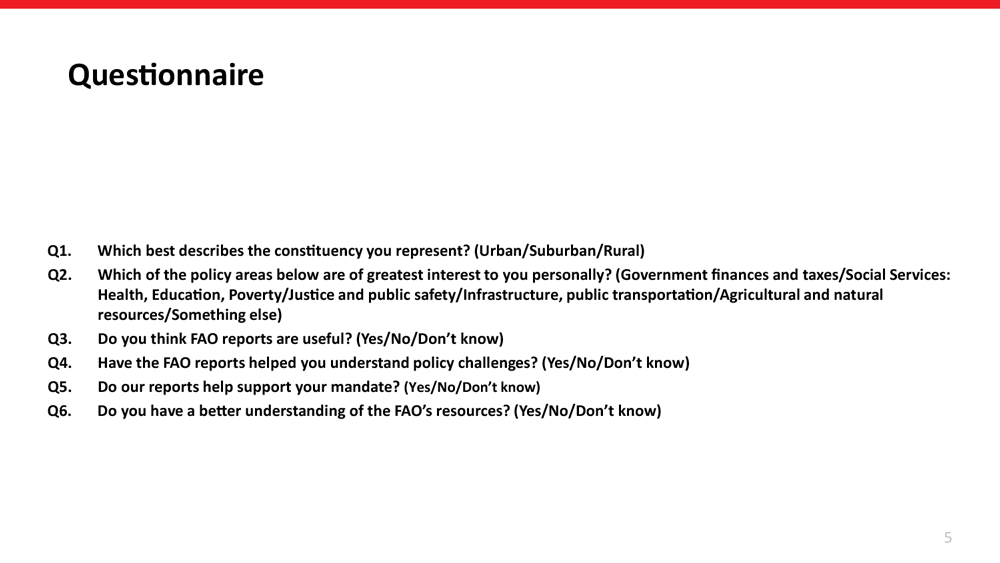
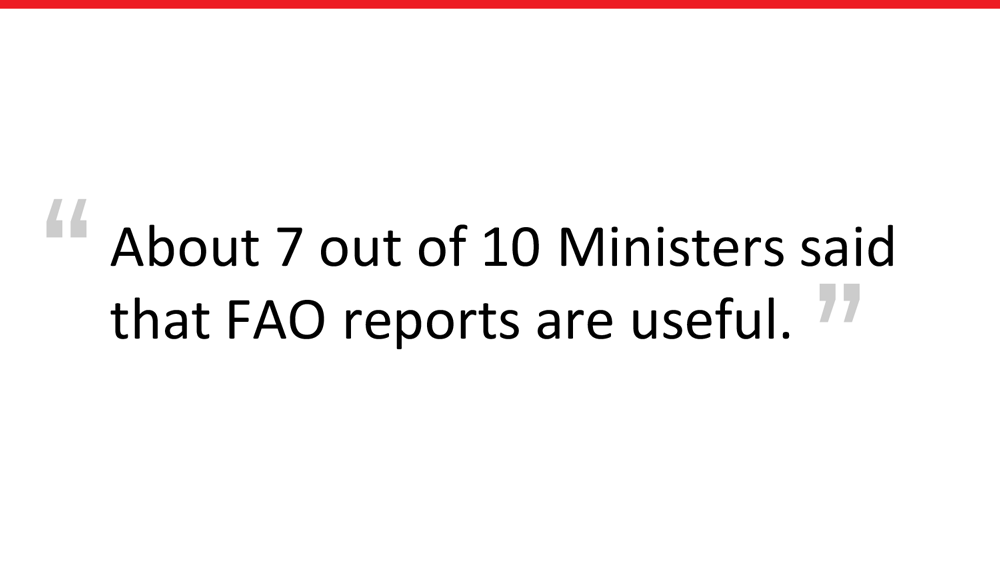
Summary of the MPP Engagement Surveys: MPPs believed that the Caucus has a better understanding of the FAO, but effort should be made to communicate how the organization supports MPPs with their mandates. Seven out of ten Ministers said that the FAO reports are useful.
- The “MPP Engagement Survey” reviewed the usefulness of FAO Estimates reports and other services. The survey showed that for respondents who were familiar with the FAO, all had read one or more reports; the reports were widely used in committee meetings to help guide questions of inquiry toward ministries and the reports helped MPPs better understand the government’s policy objectives and potential risks. The survey also showed that MPPs were open to new approaches to communication including infographics, succinct quick facts bullets, and video explainers that provide additional insight.
- The “Interactive Presentation” incorporated a concurrent electronic survey with real-time feedback enabling the FAO to immediately incorporate the results into future work. The Progressive Conservative Caucus agreed to participate in this new and innovative research approach, which helped to gauge the usefulness of FAO’s reports. Results showed that following the presentation, three quarters of the caucus had a better understanding of the FAO; seven in 10 found FAO reports useful; and the majority felt FAO reports helped them better understand policy challenges.
The MPP surveys provided the FAO with important insights that have helped guide the office’s new engagement strategy, including explainer videos and infographics that highlight key takeaways from each report. Additionally, the FAO launched Fiscal Fridays to improve financial literacy among MPPs and their constituents. Together, the FAO’s new digital strategy aims to create greater awareness of our work and cement the FAO’s position as the trusted source for provincial fiscal and economic analysis.




Access & Disclosure of Information
Access to Information
2019-20, the FAO maintained its professional working relationship with the executive branch, ministries, deputies, and public entities, with each helping to provide the FAO with timely access to all necessary information as legally required.
Access to government information is a key requirement of the FAO’s work, forming the base content for economic and fiscal analysis in support of the Legislative Assembly.
Ministries and public entities have a statutory duty to provide the FAO with information that the Officer believes necessary to perform his mandated duties, subject to only limited exceptions. In addition, two orders in council provide the FAO with access to certain information contained in Cabinet records from the current Executive Council, presided over by Premier Ford, and the previous Executive Council, presided over by former Premier Wynne.
Without access to government information, especially Cabinet records, the FAO could not operate at current levels, both in terms of number of reports produced and the quality of analysis in many of its report. As such, it is important that all MPPs understand the relevance and value that this information brings to the legislature’s ability to hold the government to account.
Disclosure of Information
Although the FAO has access to a wide range of information, the Financial Accountability Officer Act, 2013 and the orders in council place important restrictions on the FAO’s ability to disclose government information.
Accordingly, the FAO has put in place internal processes that ensure information subject to these restrictions is not disclosed. As part of these processes, ministries and public entities provide advice to the FAO, which helps ensure that the FAO complies with its disclosure restriction obligations.
Budget & Administration
Overview
The FAO’s approved budget for 2019-20 was $3,711,000. The office’s approved staffing for 2019-20 was 20 full-time equivalent (FTE) positions. By the end of the fiscal year, the office reached its full staffing complement for the first time. This largely explains why the FAO spent all of the approved budget for the first time since the creation of the office in 2015.
The FAO is a small office that produces a significant number of analytical reports that deal with the complex subjects of the Ontario economy, the Province’s finances and government policy. Considerable effort and care are taken to ensure that the office is recruiting and retaining the right staff. This is done by providing a stimulating and challenging work environment and by ensuring staff have access to the proper tools, training and support.
At the same time, we remain mindful of the critical importance of spending public money wisely and effectively. As a result, work is ongoing to strengthen policies and practices in information management, human resources, operations management, and communications. Having a full complement of staff has allowed us to continue to serve MPPs effectively, managing the increased volume of requests for analysis and information as a result of our newly invigorated outreach efforts over the past year.
Financial Statement
Financial figures are rounded to the nearest dollar and prepared on a modified cash basis. The figures for 2019-20, 2018-19, 2017-18, 2016-17 are from the province’s Public Accounts.
2019-20
$
unaudited
2018-19
$
unaudited
2017-18
$
unaudited
2016-17
$
unaudited
Approved Budget
3,711,000
3,225,000
3,225,000
3,225,000
One-time transfer*
16,791
-
-
-
Expenditure
Salaries and wages
2,383,145
1,827,927
1,658,914
1,749,177
Employee benefits
397,639
327,273
305,845
278,298
Transportation and communication
17,076
41,915
19,796
21,441
Services
873,536
727,558
542,238
510,091
Supplies and equipment
56,395
76,421
39,269
56,181
Total Expenditures
3,727,791
3,001,094
2,566,062
2,615,188
Unused Appropriation
0
382,906
658,938
609,812
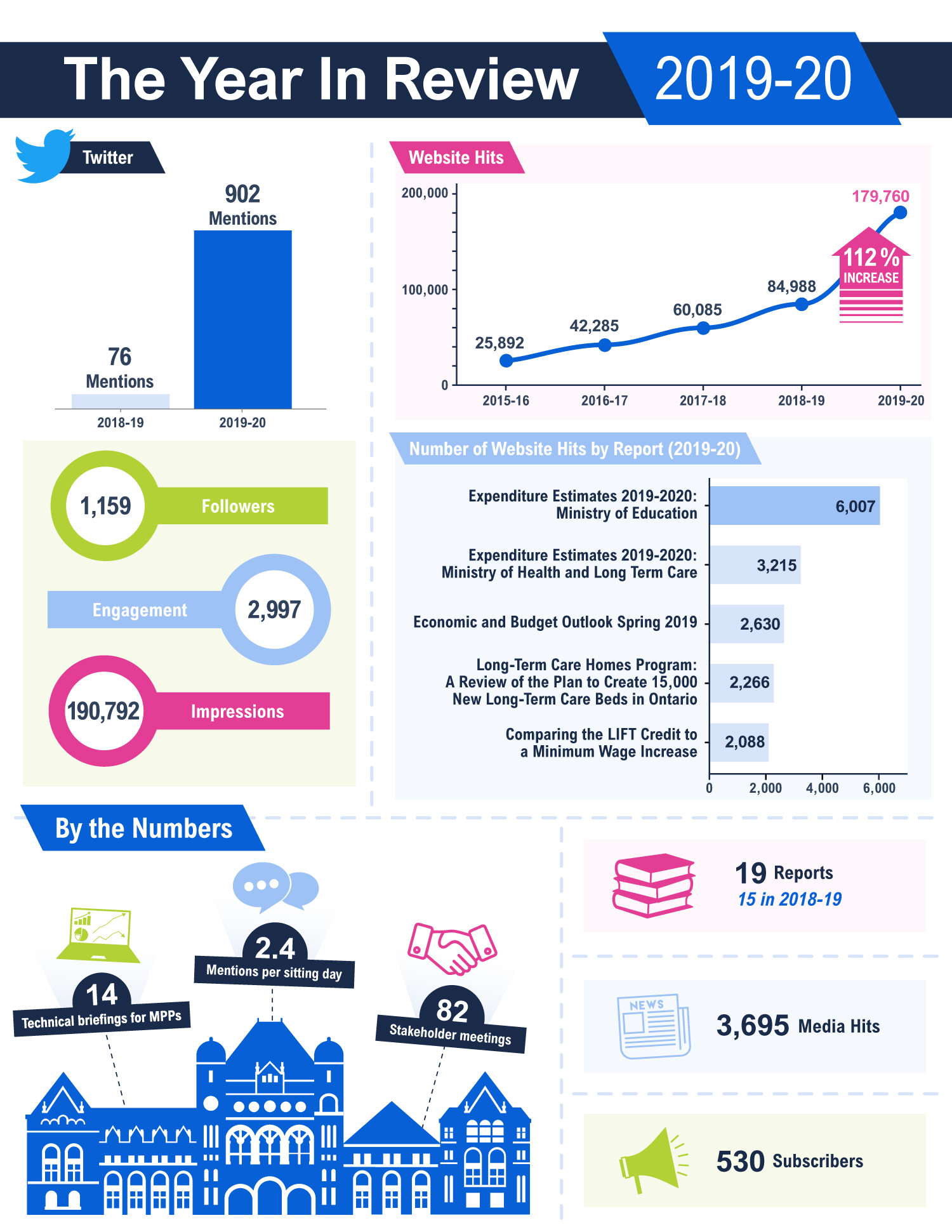
The infographic provides a summary of engagement metrics in 2019-20. The FAO produced 19 reports in 2019-20, four more than the previous year. The website had a total of 179,760 views, a 112 per cent increase from 2018-19. The largest number of website hits was for the Expenditure Estimates 2019-2020: Ministry of Education report which saw 6,007 hits, followed by Expenditure Estimates 2019-2020: Ministry of Health and Long-Term Care report which saw 3,215 hits and the Economic and Budget Outlook, Spring 2019, which saw 2,630 hits. Looking at media engagement, the FAO had 3,695 media hits this year. Our subscribers grew to 530. The FAO held 14 technical briefings for MPPs and 82 stakeholder meetings. The FAO was mentioned on an average of 2.4 times per sitting day in the Assembly.
The FAO was mentioned 902 times on Twitter in 2019-20, compared to the 72 mentions in 2018-19. The follower count reached 1,159 in 2019-20 with 190, 792 impressions and an engagement of 2,997.
About this document
Established by the Financial Accountability Officer Act, 2013, the Financial Accountability Office (FAO) provides independent analysis on the state of the Province’s finances, trends in the provincial economy and related matters important to the Legislative Assembly of Ontario.
This report was prepared by Jessica Martin, Jemimah Newton, and Ruby Pajares under the direction of Victoria Coste.







